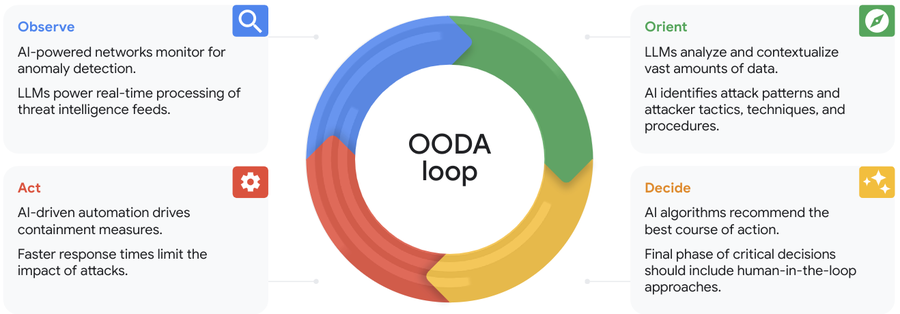Lightning-fast decision-making: How AI can boost OODA loop impact on cybersecurity

M.K. Palmore
Director, Office of the CISO, Google Cloud
Get original CISO insights in your inbox
The latest on security from Google Cloud's Office of the CISO, twice a month.
SubscribeThere’s more to cybersecurity than merely knowing the threats you face. It’s equally important to act to stop those threats, and, in doing so, to make your decisions quickly and decisively. To provide business leaders the knowledge and insights they need to make the best security decisions as quickly as possible, many organizations have turned to the OODA loop framework.
OODA means Observe, Orient, Decide, and Act, and was pioneered by U.S. Air Force Colonel John Boyd in the 1970s. Using his experience as a pilot and strategist in the Korean and Vietnam Wars, Boyd observed the need for quick, life-saving decisions in the middle of chaotic aerial combat situations. He theorized that by quickly moving through a decision cycle and taking action based on all available information, pilots could gain an advantage over the adversary — defeating them and potentially save their own lives.
“The well-functioning security team of the future is one that moves fast with accuracy to detect, disrupt, and respond to the actions of even the most capable adversary. Security teams and their leaders who can move quickly through the OODA loop could make the difference in preparedness and resiliency,” said Phil Venables, CISO, Google Cloud.
For cybersecurity to get the utmost advantage from gen AI and foundation models, more understanding of the potential benefits — such as the ability of AI to drive new security outcomes — is needed. That’s why at Google Cloud’s Office of the CISO, we advocate for adopting the OODA loop in concert with gen AI to strengthen your cybersecurity posture.
Your ability to defend your organization against attacks in a dynamic threat landscape can depend on how fast you can respond. Rapid response coupled with and driven by deep analysis has often been elusive for cybersecurity practitioners — until now. The impact of new and emerging technologies associated with generative AI and foundation models brings us to a unique moment in the defense of digital systems, where we expect the scales to tip in favor of defenders.
Here’s where the OODA loop can help. For cybersecurity to get the utmost advantage from gen AI and foundation models, more understanding of the potential benefits — such as the ability of AI to drive new security outcomes — is needed. That’s why at Google Cloud’s Office of the CISO, we advocate for adopting the OODA loop in concert with gen AI to strengthen your cybersecurity posture.
How the OODA loop can accelerate change
The OODA loop can serve as a framework for viewing the current and future challenges cybersecurity practitioners face, especially if we can all agree that speed and accuracy in decision-making can provide a distinct advantage to the defender.
Importantly, the OODA loop serves as a “core construct” for a way of thinking and acting that unifies “psychology, systems theory, game theory, and other concepts from military science,” wrote A.S. Dreier.
John Boyd asserted, based on his experiences, that whomever can handle the quickest rate of change is the one who survives combat — and in business.
“Thinking about operating at a quicker tempo — not just moving faster — than the adversary was a new concept in waging war,” wrote Robert Coram in his seminal Boyd biography, Boyd: The Fighter Pilot Who Changed the Art of War. “Generating a rapidly changing environment — that is, engaging in activity that is so quick it is disorienting and appears uncertain or ambiguous to the enemy — inhibits the adversary’s ability to adapt and causes confusion and disorder that, in turn, causes an adversary to overreact or underreact.”
Revolutionize the OODA loop framework with AI
AI can help boost the OODA loop's abilities to monitor anomalies and detect threats, adding context and identifying attack patterns, recommending courses of action for people to review, and finally drive containment measures which, thanks to faster response times, can limit the blast radius of attacks.
Early indications point to a gen AI presenting defenders with clearer visibility, digestible insights, automated playbooks, and an increased efficacy and ability to act on alerts that indicate a potential threat or an evolving attack much faster than previously possible. Decreasing time-consuming repetitive actions, bolstered by natural language queries and the ability to quickly convert insights into protective measures can, over time, give defenders the upper hand.


The four stages of the OODA loop, and how AI can give it a boost.
Google’s pioneering work in gen AI has now come to market, just as the broader cybersecurity community expects AI to have a big impact on both attackers and defenders. We believe that gen AI and foundation models will be transformational force multipliers across the cybersecurity landscape.
This includes our gen AI improvements to products like Security Command Center, Google Security Operations, and Google Threat Intelligence, our development of the Secure AI Framework, and our ongoing research to develop gen AI boldly and responsibly, which provide defenders with the kind of speed and velocity in decision-making necessary to defend today’s global enterprise.
OODA success: proven on the battlefield and in business
Today, the OODA loop framework is still taught to military leaders as a way to increase responsiveness and decision-making in the context of the battlefield, where speed and the ability to maneuver and move resources is paramount to victory. It’s also found a home in business education.
Speed and accuracy in decision-making are needed for success in today’s competitive markets, and leaders have turned to OODA to help increase the ability of teams to make quick decisions that can lead to advantages across the business landscape. Often, OODA can help you be first to market with a product or solution; it can also help create substantive pathways to success in competitive markets.
Businesses have looked at ways to apply the OODA loop framework almost from its inception, and many of today’s MBA programs teach it to their students. The Harvard Business Review has highlighted a number of use cases, including Dell Technologies, Scotts Miracle-Gro, and Zappos.
Leap into the OODA loop
The time has come to take a giant leap forward. Google Cloud can help you apply the OODA loop framework to redefine your cloud security future.
To learn more, please visit our CISO Insights Hub, and contact our Office of the CISO for more information.



